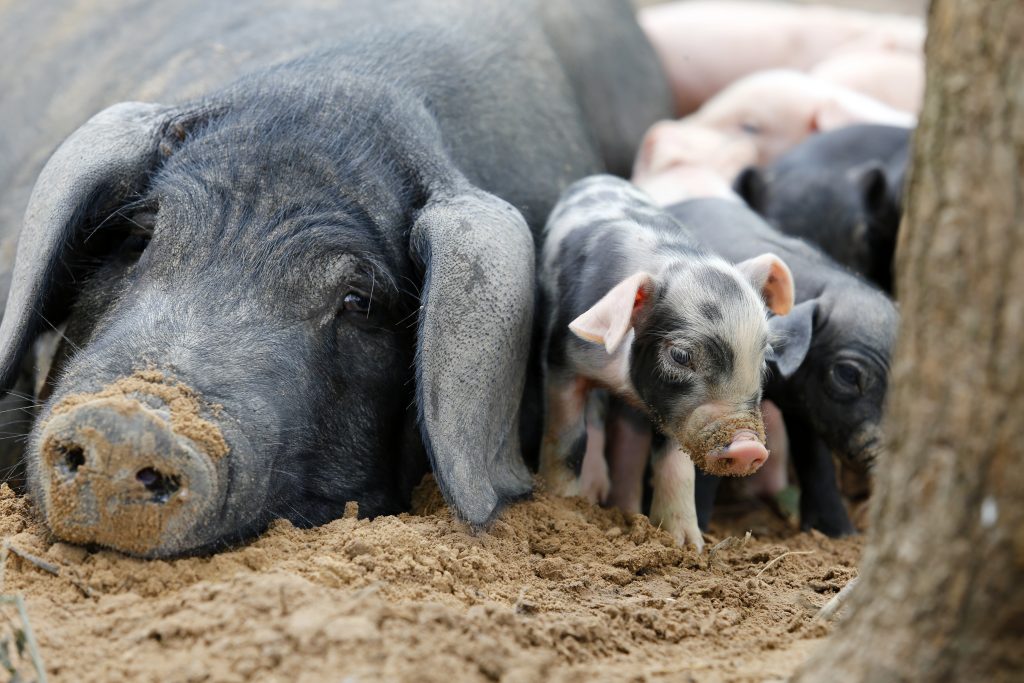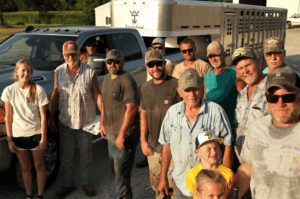Nicole and Aaron Bradley’s diversified livestock farm is a far cry from the industrial pig operations that dominate the landscape in North Carolina, the second biggest pork-producing state in the US.
Instead of confining thousands of animals and managing their millions of litres of waste in lagoons that release methane, a potent greenhouse gas (GHG), the Bradleys raise 200 pigs at a time on pasture and in wooded areas, where the animals’ manure is integrated into the ground naturally as fertiliser. Similarly, they move their 40 grass-fed cattle using a “mob” grazing system that maximises soil health, with laying hens following behind.
“One of the biggest things we focus on is biodiversity of plants and wildlife. We’re trying to create and steward ecosystems,” says Aaron. Research shows that systems that integrate managed grazing, permanent soil cover and added biodiversity can take carbon out of the atmosphere and increase a farm’s ability to confront weather extremes.
You might imagine that Colfax Creek Farm, North Carolina, would be first on the list to benefit from agricultural carbon markets, touted by politicians and the Biden administration as a way to help the US reduce emissions while boosting farmers’ incomes. However, some farmers and climate activists say smaller diversified farms using regenerative practices will not benefit financially. Carbon markets could also lock in monoculture crop systems and industrial-scale animal operations that degrade the environment and make it harder for smaller farms to compete.
“If farms are small or have more diverse operations that bring in other benefits around biodiversity and water, but not narrowly only about carbon, they’re closed out,” says Ben Lilliston, director of rural strategies and climate change at the Institute for Agriculture and Trade Policy (IATP), which has published a report on carbon markets. “It’s yet another market that tilts the playing field against [these] operations.”
IATP was one of more than 200 organisations that wrote to Congress opposing the Growing Climate Solutions Act, which aims to help more farmers get paid for sequestering carbon.
The legislation has a long list of supporters, including the biggest food and agriculture corporations, such as Bayer, Cargill and McDonald’s, and commodity agriculture groups such as the National Pork Producers Council and the National Corn Growers Association, and some environmental organisations.
“I think that, unfortunately, having the support of the biggest multinational agribusinesses and organisations like the American Farm Bureau Federation has given folks the false illusion that family farmers support this,” says Jake Davis, senior policy adviser for Farm Action Fund. “There is a lot of scepticism about these markets.”
Supporters say carbon markets can encourage farmers to invest in better practices by eliminating the financial risks of doing so. Companies that want to offset their own emissions buy carbon credits, and when farmers make improvements they are paid for carbon sequestered in their soil.
However, questions such as whether a meaningful amount of carbon can be captured, how long it stays in the ground and how to measure sequestration remain unanswered and a number of studies on current markets that are not focused on agriculture have found offsets used in calculations often don’t represent true emissions reductions.
Also controversial is that, if carbon markets gain traction more could offer credits to industrial-scale animal operations that capture methane from pig and dairy lagoons.
“Smaller farms with more sustainable agricultural practices are excluded, worsening inequities in our agricultural system,” says Laurie Beyranevand, director of the Center for Agriculture and Food Systems at Vermont Law School. “Plus, biogas technology produces other dangerous air and water pollutants and releases carbon dioxide during combustion, and that pollution often disproportionately burdens vulnerable communities that surround the facilities, raising environmental justice concerns.”
Still, Davis says the idea of a carbon credit as a revenue stream for farmers is not necessarily a bad one, and Farm Action Fund might support a system that resolved some of those issues and tackled questions of who will really benefit.
Current carbon markets pay farmers about $15-20 (£10-£14) an acre for capture, a sum that isn’t meaningful unless the farm covers at least hundreds, and more likely thousands, of acres. Companies that sell carbon credits say the price will rise as markets gain traction.
A spokesperson for the Democratic Michigan senator Debbie Stabenow, who jointly reintroduced the Growing Climate Solutions Act, says the legislation was revised to ensure equitable access to markets.
Many markets also only serve arable farmers. And farmers must make at least one practice change – such as reducing tillage or fertiliser use – to qualify for credits.
“As someone who has dedicated his life to regenerative farming practices – even made financial gambles to develop those systems on our farm – there is definitely something offputting about the idea of rewarding large-scale farmers who, for instance, can plant some acreage in cover crops but then keep the rest of the operation conventional,” says Jesse Frost, who co-runs Rough Draft Farmstead, a no-till, organic vegetable farm in Kentucky. “This is especially true since farmers like me may not be entitled to these same rewards.”
Stabenow’s spokesperson says some private markets do pay for past conservation actions. But Beyranevand says it would be better to expand Department of Agriculture programmes that already invest in environmental practices on farms of all sizes.
Aaron Bradley says that while his farm cannot compete with the price efficiency of industrial-scale animal operations, it is more efficient in other ways “in preserving natural resources and managing ecosystems that can hold carbon. Our policymakers are disconnected from what our style of agriculture is, and I’m not sure they believe we can really be productive.”



